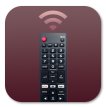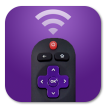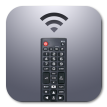
When your TV remote stops working, it may be due to dead batteries, a blocked signal, or something more mysterious. In this blog, we'll walk you through the most common reasons for the TV remote not working and the troubleshooting process.
Table of Content
Why Is My TV Remote Not Working
Let's start with the basics about a smart TV remote not working. Here are the most common causes for the issues, from dead or weak batteries to TV issues, like TV freezing.

- Dead or weak batteries
Why is the TV remote control not working? When a remote has weak or dead batteries, it will act up. Therefore, when your TV remote does not work, install a fresh set of batteries.
- Obstructed signal
Most TV remotes use infrared (IR) signals to control a TV, which needs a clear line of sight to the TV's sensor. In other words, if something is blocking the path, the signal won't reach the TV, and your remote won't work no matter how hard you press the buttons.

- Connection lost
Many modern smart TVs come with Bluetooth or Wi-Fi-enabled remotes, like the Roku Voice Remote. These remotes require an initial pairing process to connect with the TV. If the remote becomes unpaired due to a software update, power loss, or accidental reset, the remote won't work even with new batteries.
- Remote glitches
When a TV remote is not working, it may have internal glitches. Just like your smartphone or computer, a TV remote can experience minor software glitches or freeze up unexpectedly, especially if it is a smart remote with advanced features. These internal glitches may cause buttons to stop responding, like the TV remote power button not working.
- TV glitches
Don't forget your TV. Sometimes, a TV remote can't change the channel or volume, and the TV is the problem. Modern TVs can experience software glitches, system freezes, or memory overloads, especially if they've been running for a long time without being turned off.
- Damaged remote
The last reason for a TV remote not working is that the remote is broken. Accidental drops, liquid spills, or general wear and tear can silently damage internal components, making the remote unresponsive. To prevent this, it's a good idea to store your remote in a designated holder or safe spot when not in use.
The quickest solution to the broken remote is to replace it with a new one. Many third-party universal remotes or official replacements are affordable and easily set up.

Now equipped with the reasons for the TV remote control not working, you can try repairing your unresponsive remote with the solutions as follows. Scroll down to the next part on how to fix a TV remote that is not working.
Fix 1. Check the Batteries
Slide open the battery compartment on the back of your TV remote. There's usually an arrow showing which way to push. Then, check the batteries to make sure they're properly in place and facing the right direction. If everything looks fine but the remote still isn't working, it might be time for a fresh set.
When did you last change the batteries? Most remote batteries last around three to six months. So, if it's been a while, just swap them out for new ones and make sure they're installed the right way. Before installing the new ones, see if corrosion marks are on the battery contacts. If you spot any rust, clean it.
After installing the new batteries, press a button on the TV remote and check if your TV responds to your remote. If your remote works again, weak or dead batteries are the problem.
If you changed the batteries recently, but they drained fast, I have some tips in Solved: My Roku Remote Drains Battery Fast to help you prolong your battery lifespan.
If you have a rechargeable remote, and find the TV remote not working but light blinks, there are a series of operations to confirm whether the battery is the source of the issue:
Step 1. Check the remote's battery level via the TV system settings. If the battery is low or unknown, this may indicate a battery-related problem. Considering your remote is not working, it's recommended to turn your phone into a remote and navigate across your TV.
Step 2. Connect the remote to a reliable power source using the original charging cable (like USB-C or Micro-USB). Allow it to charge for at least half an hour to ensure adequate power.

Step 3. Check the charging indicators on the remote. Most rechargeable remotes feature an LED indicator light that shows the charging status, such as red for charging and green for fully charged. If no light appears, there may be an issue with the battery, charging port, or cable.
Step 4. After charging, try turning on the TV or controlling volume using the remote. If the remote remains unresponsive, the battery may be depleted or faulty.
If your remote has been in use for more than a year, the rechargeable battery may have deteriorated due to repeated charging cycles. In such cases, you may need to contact the manufacturer or authorized support center to inquire about battery replacement ot obtaining a new remote.
Fix 2. Check for Obstructions
As stated above, any obstructions between your remote and the TV can block the infrared signals from reaching the receiver on the TV, causing the TV remote not to work. So, look for your room for potential obstructions and move them away from the line of sight between the remote and the TV.
Furthermore, check the infrared emitter on the remote and the infrared receiver on the TV. You need to ensure they are not covered in dust or any other types of debris by removing them with a soft microfiber cloth; otherwise, they will impede infrared signal transmission.

Fix 3. Clean the Remote
Is your TV remote button not working, like the TV remote volume not working? The issue may be due to dirt buildup, worn-out buttons, or internal contact problems. Here's how to address this:
Step 1. Press each button individually to see if they respond. Pay close attention to the volume buttons or others that are not functioning. If some buttons work and others don't, this suggests a localized issue rather than a full remote failure.
Step 2. Clean the remote with a soft, dry cloth, especially the edges of the buttons. If necessary, lightly dampen the cloth with water or rubbing alcohol.
Step 3. Remove stuck buttons by gently tapping the remote against your hand with the buttons facing downward. Plus, use a soft brush or compressed air to dislodge debris from around the buttons.
Step 4. Inspect the remote for any visible cracks or broken buttons. If the remote has been dropped or exposed to moisture, internal damage may be the cause.
Step 5. Test your remote again, especially the buttons that were not working.
Fix 4. Reset the Remote
If cleaning the remote doesn't resolve the issue, or if it behaves unpredictably, a reset may help restore normal function. Resetting your remote can clear temporary glitches, software bugs, or misconfigurations. This doesn't affect your TV settings as it only refreshes the remote's internal state.
How to reset a TV remote? Here are the steps:
Step 1. Open the battery compartment and take out the batteries.
Step 2. Leave the remote without power for at least 30 seconds to discharge the residual charge.
Step 3. With the batteries still removed, press and hold the power button on the remote for about 10 to 15 seconds. This helps drain any remaining power and clears internal memory.
Step 4. Put the batteries back in and install them properly.
Step 5. Try using the remote again to see if the issue has been resolved.
If you have a smart remote, it may require re-pairing with your TV after a reset. You can follow the remote manual or go to your TV Settings > Remote & Accessories > Pair New Remote (exact path may vary by brand). The third option is to check the how-to guides from BoostVision if you have a device from Roku, Amazon, LG, Samsung, Vizio, etc.
- How to Pair Roku Remote with Pairing Button
- How to Pair Firestick Remote to TV
- How to Pair Vizio Remote to TV
- How to Pair Insignia Remote
- How to Pair LG Remote to TV
- How to Connect Old Samsung Remote to TV
Fix 5. Restart the TV
When a TV remote does not work, the issue may be the TV, not the remote at all. If your TV remote is not working, you can try restarting the TV. Restarting the TV can help clear temporary software glitches or connection issues.
- Option A: press the power button on the TV (usually on the side or underneath the screen), wait a few seconds, and then turn the TV back on.
- Option B: turn off the TV by pressing the power button, unplug the power cord from the outlet, wait for at least 30 seconds to 1 minute to allow the system to fully power down, then plug the TV back in, and turn it on.
- Option C: if you can control your TV through buttons on the TV or a mobile app, Settings > System > Restart or Settings > Power > Restart (exact steps vary by brand).
Fix 6. Consult the Manufacturer
If everything you tried is not helpful, your remote's internal components may be worn out. Over time, the remote's internal components such as the circuit board, buttons, or battery contacts can wear out or become damaged. In such cases, simple fixes won't restore full functionality.
Certainly, this doesn't mean no solution for you. What you can do next includes:
Step 1. Check warranty status. If your TV or remote is still covered by warranty, repairs or replacement may be provided at no additional cost.
Step 2. Have your TV model number, remote model number, and purchase information handy. This will help expedite the support process.
Step 3. Reach out to the manufacturer's official support channels via phone, email, or website. They can offer professional advice, confirm whether your remote is still under warranty, and guide you through available repair or replacement options.
Step 4. Purchase an official replacement remote if repair is not feasible or the remote is out of warranty. Avoid 3rd-party remotes unless they are certified compatible, to ensure full funtionality and avoid further issues.
Practical Tips for Using the TV Remote
I'm a huge TV fan and spend lots of time watching TV shows. The happiest moments in my whole day are relaxing on my sofa and watching my favorite shows.
However, every now and then, my TV remote is not working. Over time, I've learned a few valuable lessons on how to get the most out of the TV remote and avoid common issues.
- Set up a remote on the phone
Many modern smart TVs offer official mobile apps that turn your phone into a remote, such as Samsung SmartThings, LG ThinQ, and Roku app. Considering different TV brands in my room, I set up a universal TV remote app on my smartphone.

The remote app works across major TV brands, including Samsung, LG, Roku, Insignia, Hisense, Philips, TCL, and so on. Furthermore, it relies on either an IR or Wi-Fi network, allowing you to control your TV even if the TV loses network connection.

The app setup is simple. Just download the universal remote app on your smartphone, launch it, and choose the TV mode (smart TV remote or IR TV remote), then follow the on-screen instructions to set up the virtual remote. Once finished, you can turn on your TV without remote. Other operations are also easy to do.
Download Universal TV Remote
- Keep the remote clean and dry
Regularly wipe the remote with a soft, dry cloth to prevent dust and dirt buildup around the buttons. Avoid exposing the remote to moisture or liquids, which can cause damage.
- Handle the remote with care
Avoid dropping the remote or applying excessive force to the buttons. Gentle use helps prolong the life of the internal components.
- Replace batteries promptly
Don't wait until the remote stops working completely. Replace batteries as soon as you notice a weak or inconsistent response, such as delayed reaction, reduced range, or certain buttons not responding. So, keep spare batteries on hand.
About battery replacement, there are some precautions:
- Use fresh batteries from the same brand and batch. Mixing different brands, or even different types (e.g., Alkaline vs. rechargeable), can lead to uneven power outlets, reduced performance, or leakage.
- Never pair a new battery with an old one. This can cause the older battery to drain the newer one faster, and in some cases, lead to leakage or internal damage to the remote.
- Keep the line of sight clear
For infrared (IR) remotes, make sure nothing is blocking the path between the remote and the TV's IR sensor. Bright sunlight or other strong light sources can interfere with IR signals. What's more, while using the remote, stay closer to the TV.
- Store the remote properly
While the remote is not in use, keep the remote in a safe, accessible place to avoid losing it or damaging it accidentally.
- Regularly update the TV's software
Keeping the TV's firmware up to date can improve remote compatibility and add new features that enhance remote functionality. Most modern smart TVs have an auto-update feature, which allows the TV to automatically download and install updates. If your TV has this feature, make sure it is enabled.
Conclusion
A broken remote control may seem like a minor inconvenience, but it can ruin a moment when you're trying to unwind and watch your favorite show. Fortunately, most issues can be resolved with a few simple steps. Additionally, your phone can come to your rescue when everything else fails.
TV Remote Not Working FAQ
Q: Do TV remotes wear out?
Yes, TV remotes can wear out over time. Frequent use, accidental drops, exposure to dust or moisture, and worn-out buttons can all lead to reduced functionality. Internal components like the circuit board or battery contacts may also degrade with age.
Q: What are common problems with TV remotes?
The common TV remote issues include dead or weak batteries, blocked or dirty sensors, unresponsive or stuck buttons, signal interference, lost Bluetooth/Wi-Fi connection, physical damage from drops or spills, and software glitches.
Q: How do I know if my TV remote is bad?
If a TV remote goes bad, the signs include no response even with new batteries, only some buttons working, no LED indicator light when pressing buttons, and remote not pairing or connecting with the TV. Plus, obvious physical damage is also included.
Q: How do I start my TV if my remote is not working?
If your TV remote is not working, you can start your TV by pressing the power button on the TV. Considering convenience, you'd better set up a remote app on your smartphone, then you can control your TV with your smartphone.








